Anconodon is an extinct genus of mammal from the Paleocene of North America, and thus lived just after the "age of the dinosaurs". It was a member of the extinct order Multituberculata within the suborder Cimolodonta and possibly the family Cimolodontidae.

Helix pomatia, known as the Roman snail, Burgundy snail, or escargot, is a species of large, air-breathing stylommatophoran land snail native to Europe. It is characterized by a globular brown shell. It is an edible species which commonly occurs synanthropically throughout its range.

The umbilicus of a shell is the axially aligned, hollow cone-shaped space within the whorls of a coiled mollusc shell. The term umbilicus is often used in descriptions of gastropod shells, i.e. it is a feature present on the ventral side of many snail shells, including some species of sea snails, land snails, and freshwater snails.

Wainuia urnula is a species of air-breathing predatory land snail, a terrestrial pulmonate gastropod mollusc in the family Rhytididae.

The gastropod shell is part of the body of a gastropod or snail, a kind of mollusc. The shell is an exoskeleton, which protects from predators, mechanical damage, and dehydration, but also serves for muscle attachment and calcium storage. Some gastropods appear shell-less (slugs) but may have a remnant within the mantle, or in some cases the shell is reduced such that the body cannot be retracted within it (semi-slug). Some snails also possess an operculum that seals the opening of the shell, known as the aperture, which provides further protection. The study of mollusc shells is known as conchology. The biological study of gastropods, and other molluscs in general, is malacology. Shell morphology terms vary by species group.

Atlantidae is a family of sea snails, holoplanktonic gastropod molluscs in the clade Littorinimorpha.

Anguispira, the tigersnails, is a genus of small pulmonate land snails in the family Discidae endemic to North America. Snails in this genus are defined by their striped shells. Anguispira species are either habitat generalists like A. alternata or limestone specialists like A. cumberlandiana.
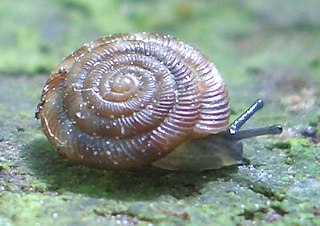
Discus rotundatus, common name rotund disc, is a species of small, air-breathing, land snail, a terrestrial pulmonate gastropod mollusk in the family Discidae, the disk snails.

Cernuella virgata, also known as Helicella virgata, common name, the "vineyard snail", is a species of small, air-breathing land snail, a pulmonate gastropod mollusc in the family Geomitridae.
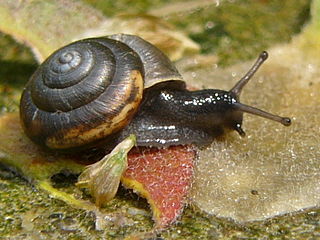
Trochulus hispidus, previously known as Trichia hispida, common name, the "hairy snail", is a species of air-breathing land snail, a terrestrial pulmonate gastropod mollusk in the family Hygromiidae, the hairy snails and their allies.
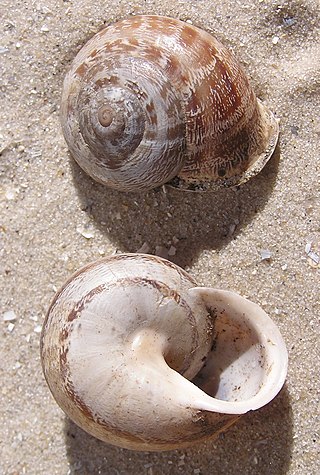
Eobania vermiculata also known as Helix vermiculata, common name the "chocolate-band snail" is a species of large, air-breathing, land snail, a terrestrial pulmonate gastropod mollusk in the family Helicidae, the true snails or typical snails.
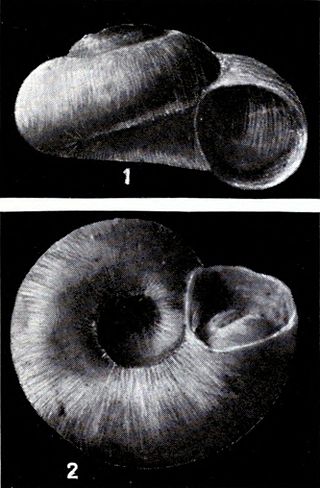
Valvata oregonensis is a species of fossil freshwater snail with a gill and an operculum, an aquatic gastropod mollusk in the family Valvatidae, the valve snails.

Cittarium pica, common name the West Indian top shell or magpie shell, is a species of large edible sea snail, a marine gastropod mollusk in the family Tegulidae. This species has a large black and white shell.
Compsemys is an extinct genus of prehistoric turtles from the Late Cretaceous and Paleocene of North America and possibly Europe. The type species C. victa, first described by Joseph Leidy from the Hell Creek Formation in Montana in 1856, and another probable species C. russelli, described in 2012, from Paleocene deposits in France. Its affinites have long been uncertain, but it has recently been considered to be the most basal member of Paracryptodira, despite the clade first appearing in the Late Jurassic, and is sometimes included in its own family, Compsemydidae. A revision in 2020 found Compsemydidae to be more expansive, also containing Riodevemys and Selenemys from the Late Jurassic of Europe, and Peltochelys from the Early Cretaceous of Europe.
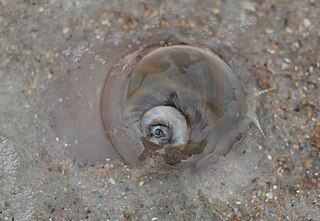
Neverita duplicata, common name the shark eye, is a species of predatory sea snail, a marine gastropod mollusk in the family Naticidae, the moon snails.
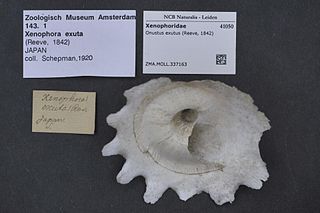
Onustus exutus is a species of large sea snail, a marine gastropod mollusk in the family Xenophoridae, the carrier shells.
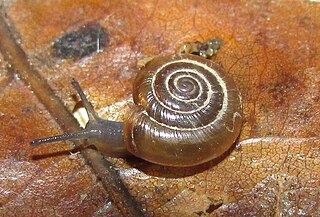
Oxychilus camelinus is a species of small air-breathing land snail, a terrestrial pulmonate gastropod mollusk in the family Oxychilidae, the glass snails.

Gudeodiscus giardi is a species of air-breathing land snail, a terrestrial pulmonate gastropod mollusk in the family Plectopylidae.

Euthema is a fossil genus of minute land snails with an operculum, terrestrial gastropod molluscs in the family Diplommatinidae from the Cretaceous Burmese and Hkamti ambers.
Anguispira holroydensis was a species of pulmonate land snail in the family Discidae, the disk snails. The species is only known from fossilized specimens. It was first described by Loris S. Russell in 1956.
















